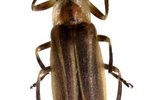
Sexing spiders isn't always an easy task, nor is it one that everyone will be able to accomplish on all types of spiders. It's not always important to know the sex of a spider, but in some instances, one sex is much more dangerous than the other. In some species, the sexual dimorphism is so great that it's relatively simple to tell the different sexes; in others, you might need to break out the microscope.
Sexual Dimorphism: Colors
In some species, coloration can quickly tell you the difference between a male and female. A common example is the black widow. The female is the one most commonly thought of: black, globular body with long, outstretched legs and the tell-tale red hourglass. The male is lighter in color and has a reddish-orange stripe down his back with colorful streaks of yellow and brown radiating across his abdomen. The golden silk spider (Nephila clavipes) is another example: the female has a yellow-spotted silver carapace covering her orange to tan body; the male is simply dark brown and not easily noticed in the landscape.
Sexual Dimorphism: Size
In most spiders, the female is significantly larger than the male -- often more than double. Using the example of the golden silk spider, the female isn't only more colorful, she's six times longer than the male. The female is 3 inches long compared to the male at a half-inch at most. In the black widow, the female typically reaches about 1 1/2-inches long while the male is approximately 1 1/4 inches. The daring jumping spider, a common sight throughout much of the United States, also has a slightly larger female than male.
Pedipalps
The pedipalps are two mouthparts located between the chelicerae, or jaws, and the first pair of legs. They're jointed and look like a smaller, additional pair of legs. Spiders use their palps as an insect uses its antennae; the palps sometimes aid in web-building or capturing prey. The male spider has an enlarged pair of pedipalps, sometimes resembling a pair of arms with boxing gloves on. In many species, you can easily identify a male because of his enlarged, rounded pedipalps, which he uses to transfer sperm to the female during mating.
Microscopic
Because tarantulas are commonly kept as pets and in labs, sexing them can be important. It's not as simple as looking for size, color or palp differences, however. The true science when it comes to sexing tarantulas and some other groups is using a microscope. Males have extra fusillae, which aids in spinning sperm webs. Examining the exuvium with a stereoscopic light microscope is another scientific method; the female molts her spermathecae, or sperm receptacle, along with the rest of her skin. The presence of the spermathecae indicates a female. These methods are not for the beginner; both take dedicated practice and experience to properly identify the sexes. Males are identifiable once they have reached sexual maturity after their final molt due to the bulbs on the end of their palps.
References
Photo Credits
-
Hemera Technologies/Photos.com/Getty Images
Writer Bio
With a professional background in gardening, landscapes, pests and natural ecosystems, Jasey Kelly has been sharing her knowledge through writing since 2009 and has served as an expert writer in these fields. Kelly's background also includes childcare, and animal rescue and care.




